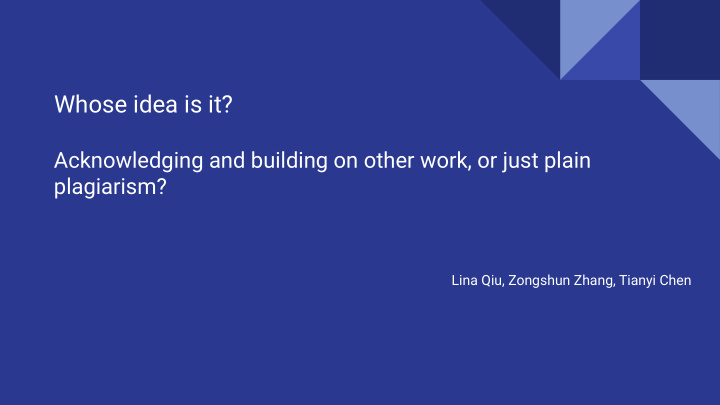



Whose idea is it? Acknowledging and building on other work, or just plain plagiarism? Lina Qiu, Zongshun Zhang, Tianyi Chen
Outline ● What is plagiarism Common Types ● Avoid Plagiarism ● ○ Troubles Causes ○ ○ Discussions Citation ○ ● Check Tools ● Conclusion
What is Plagiarism Dictionary: The practice of taking someone else's work or ideas and passing them off as one's own. ● Intentional ● Acidential
Survey https://www.plagiarism.org/article/plagiarism-facts-and-stats
Types of Plagiarism [4]
Special Case - Mosaic Plagiarism ● Copying from different sources and putting them together. ● It includes slightly rephrasing. ● Requires a bit more effort than just copying
Special Case - Self Plagiarism An author reuses portions of their previous writings in subsequent research papers. ● Flood conferences and journals with near-identical papers ● Reward those authors to break down their results into overlapping least-publishable-units , and publish each result once at a time Whenever a self-plagiarized paper is allowed to be published, another more deserving ● paper is not
Why to Avoid Plagiarism [6] ● Act of simple theft Financial starvation ● Famatory suicide ● ○ “When a reputation dies, it is rarely reborn anew, …” Anything to share? Experience of protecting yourself from others’ plagiarism? ● “Without struggling to understand, interpret, and argue with ideas, your own ideas never develop fully, and you will tend to see issues superficially (again, a profoundly dangerous thing in any profession and in any society).”
Causes [5] ● Time-management Ignorant of consequences ● ○ “Instructors and institutions may fail to report cheating when it does occur, or may not enforce appropriate penalties.” Fear failure ● ● Struggling with a second language ● ...
Accidental Plagiarism [5][7] ● Cultural Confusion Failure to cite a source that is not common knowledge. ● Failure to "quote" or block quote author's exact words, even if cited. ● ● Failure to put a paraphrase in your own words, even if cited. ● Failure to put a summary in your own words, even if cited. Failure to be loyal to a source. ●
How to avoid [5] ● “Instructors are there to guide you and help you learn, part of that is with plagiarism and citation issues.” ○ What are the rules on using outside sources? ○ How do you cite not original sources?
Citation format [8][9] ● ACM/IEEE/APA/MLA/… Conference/Journal/Book/Website/Patent/… ● In-Text/Citation List ●
Cite, Quote and Paraphrase [2] Quote: To state what someone else has written, word for word, using their words. ● Anything you directly quote must be put in quotation marks and referenced Paraphrasing: To paraphrase is to say the same thing, but in your own words. ● Give credit at the end of the paper in the bibliography or through footnotes.
Check Tools Google and Google Scholar BU Center for Teaching & Learning [3] : ● Turnitin.com ● SafeAssign (Integrated with Blackboard) MOSS from Stanford (code) Any else?
Quiz time! [1] Plagiarism or not? ● Cite all sources, but have no original work or ideas ● Copy word for word without quotation but with citation Copy images without citation/modify images slightly ● Rehashing majority of your own work in another paper ● ● Cite a source for work it doesn’t contain
Conclusion 1. Don’t be lazy and study hard. 2. Respect other people’s work, respect knowledge.
Citations [1] "Acknowledging and building on other work, or just plain ...." https://www.cs.bu.edu/~richwest/cs697_spring_2019/slides/plagiarism.pdf. Accessed 4 Apr. 2020. [2] "Avoid Plagiarism - Research & Subject Guides - Stony Brook ...." 30 Mar. 2020, https://guides.library.stonybrook.edu/citations/avoid-plagiarism. Accessed 4 Apr. 2020. [3] "Plagiarism Detection » Center for Teaching & Learning ...." 31 Mar. 2020, https://www.bu.edu/ctl/teaching-resources/plagiarism-detection/. Accessed 4 Apr. 2020. [4] "6 Types of Plagiarism and How to Avoid Them (With ... - Scribbr." 17 Jan. 2018, https://www.scribbr.com/plagiarism/types-of-plagiarism/. Accessed 4 Apr. 2020. [5] "Avoiding Plagiarism – MIT Comparative Media Studies/Writing." https://cmsw.mit.edu/writing-and-communication-center/avoiding-plagiarism/. Accessed 4 Apr. 2020. [6] "Why is plagiarism an unacceptable academic practice? - Quora." 16 Mar. 2018, https://www.quora.com/Why-is-plagiarism-an-unacceptable-academic-practice. Accessed 4 Apr. 2020. [7] "Unintentional - Plagiarism Tutorial at Duke University." https://plagiarism.duke.edu/unintent/. Accessed 4 Apr. 2020. [8] "Purdue OWL // Purdue Writing Lab." https://owl.purdue.edu/owl/purdue_owl.html. Accessed April 8, 2020. [9] "Citation Style and Reference Formats - ACM." 23 Jan. 2020, https://www.acm.org/publications/authors/reference-formatting. Accessed 8 Apr. 2020.
Recommend
More recommend